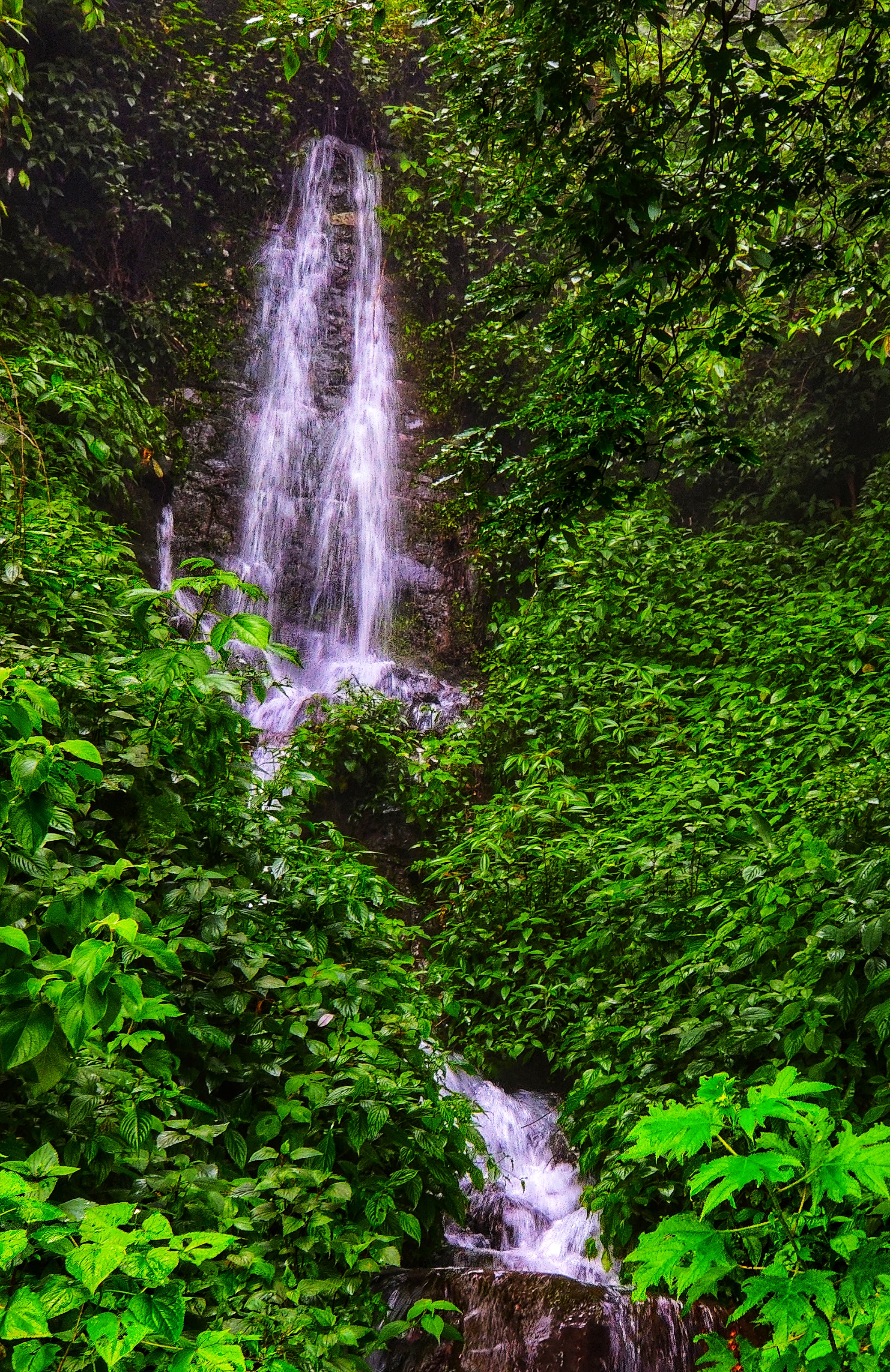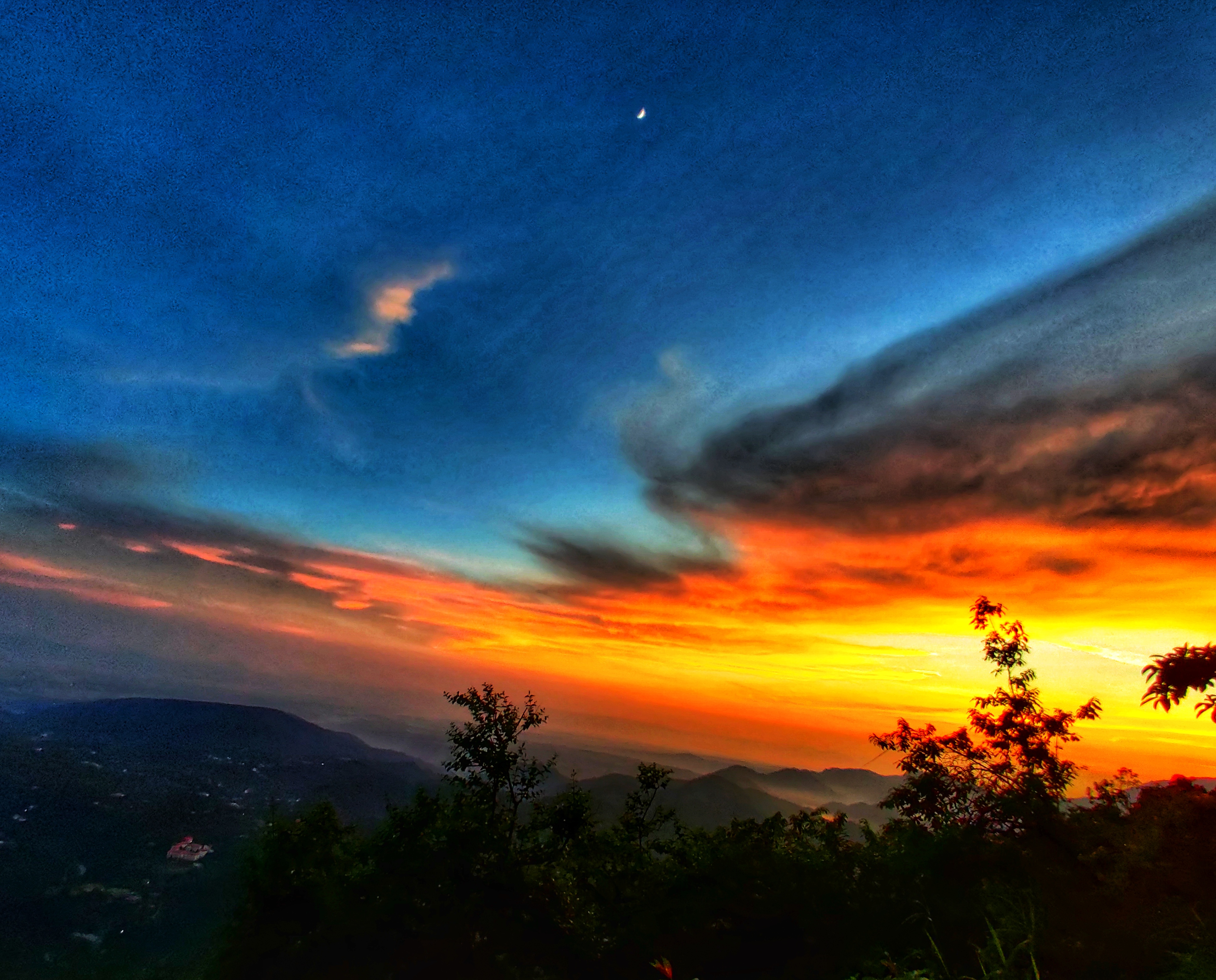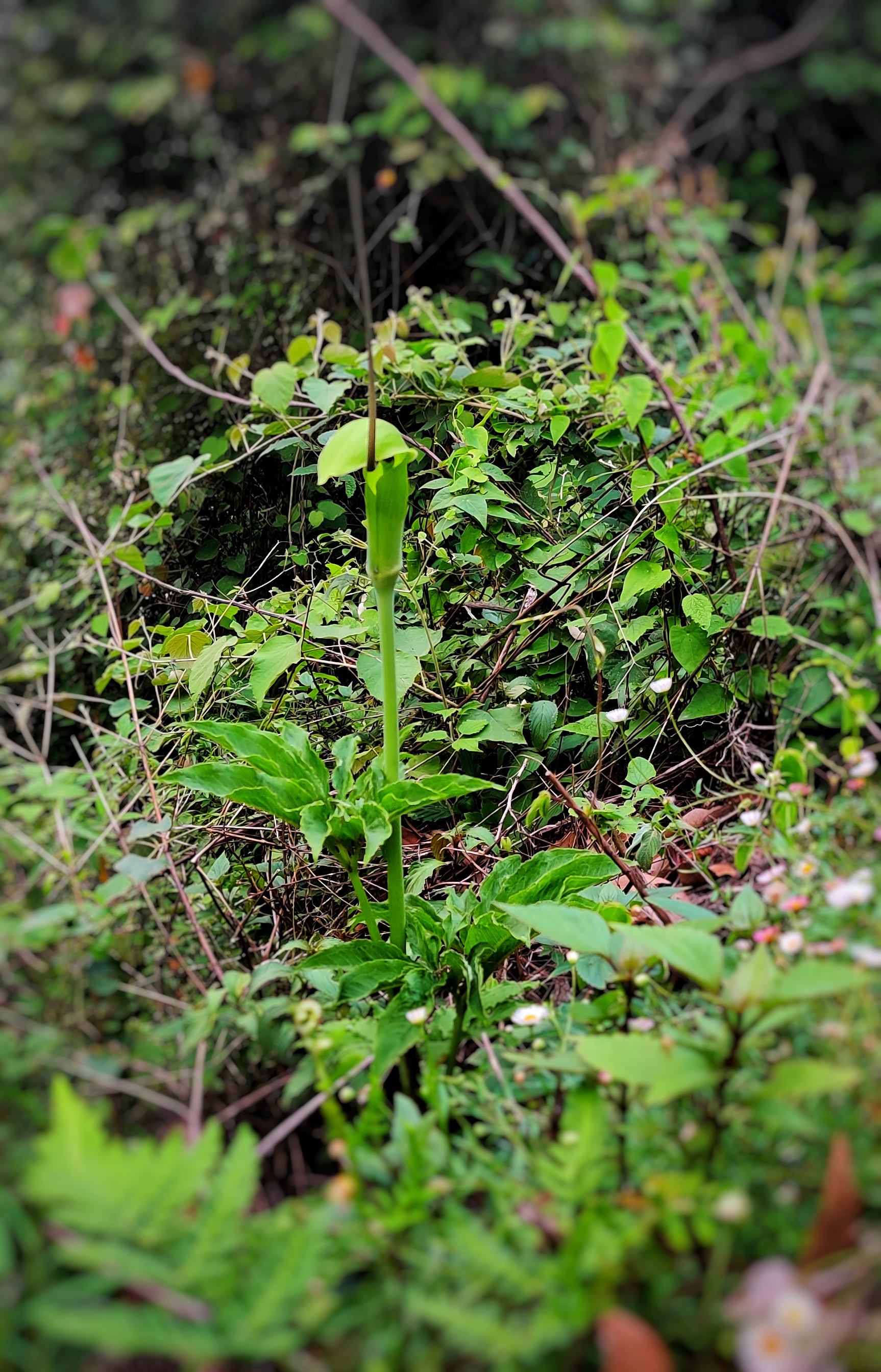Waterfall on mountain slope, Flowing with might and strength On the rocks, into the valley, Paving way through rugged terrain.. @chandrimadebi It’s been days that I went into the verdant mountains and valleys as the hillside of Landour, Mussoorie is experiencing heavy rainfalls alongwith severe landslides and thunderstorms, So, one fine morning I finally decided to feed my mind and soul and timed it well with the early morning drizzle. Although, clouds tried to create a misty haze in the surrounding Oak forest affecting visibility, I raced with time to finally reach the venue before it rained again. On the way I came across few streams which have sprung up due to heavy rains. Often these streams are near dry during winters and mid summer, but this year the creek was running strong from all the rain it had. It was a pleasant experience to hike along listening to the running water although one has to be careful enough with the approaching vehicles. I stepped ahead and found few more streams on the roadside. The rainwater flows through the roads and channels finally culminating into main channel and then drains through the hillslopes sometimes giving expression for pseudo waterfall. I won’t recommend it for drinking purpose. However, the local people around the area use the streamwater to wash clothes, clean vehicles etc. I often observed tourists sometimes stopby these streams and take shower. Also, few pictures of gods and goddesses also lie nonchalant in the catchment. Almighty’s creation is perfectly balanced although Nature has its own equations, as in some parts of the world, forests are burning, somewhere sandstorms and in someplace it’s draught, but this hillside is receiving abundant rainfall. I hope if only water conservation measures were adopted in the area, so that the dearth of freshwater shortage could be resolved around the region. With these thoughts, I took my way back home alongwith the burbling sound of waterfall. Still in the melancholy, I can hear the distant sound of the stream which is flowing just around the corner. I’m grateful for our viridescent environment when much of the country was dry and/or on fire this year. Thank you!!! Like, share and follow. ? https://www.facebook.com/Dr.ChandrimaDebi/ https://www.instagram.com/debichandrima/ https://youtube.com/shorts/CxyFXIP6heU?feature=share https://www.sumanmitra.com/ ©All images and content are subjected to copyright © 2019 – 2021 chandrimadebi.com Conserve Freshwater.. Harvest Rainwater!! @chandrimadebi
Avian visitors of Oak tree (Quercus leucotrichophora): pollination ecology
The incredible task carried by wildlife in executing pollination is exemplary. Pollination in plants is a crucial aspect in reproductive cycle of flowering plants. Wind and water also play role in the pollination of many plants, but to witness wildlife getting engaged in pollinating is a fascinating experience in itself. How the appealing flowers, their fragrance, and nectar lure the wildlife towards themselves and make them agents of pollination is an artistic manoeuvre of the plant kingdom. Nature, forests and pollinators are mutually interdependent and plants species can go extinct if the pollinators get extinct. Pollinators are agents who are responsible for assisting over 80% of the world’s flowering plants to carry on their life cycles. In this context, I would like to draw attention towards Oak tree (Quercus leucotrichophora) commonly known as ‘Banj Oak’. Very few studies have been carried out to understand the inflorescence and pollination ecology of Oak trees. Although Oak trees are wind pollinated but I have seen honey bees and certain insects and birds hovering around the flowers of Oak tree. This year Oak trees were in full bloom alongwith the onset of the spring season in the lesser Himalayan hillside. This event gave me insight into the new visitors and pollinators on the Oak tree. There is a big Oak tree outside my window and it always motivates and inspires me. Now, its captivating my interest with the avian visitors. The flowers of Oak tree are mainly wind pollinated, although I have observed honey bees hovering on the Oak tree flowers. Also, I have observed sunbirds, blue whistling thrush, Verditer flycatcher, barbet, woodpeckers, tree creepers. The Blue whistling thrush wishes pleasant good morning through its melodious song, the sunbirds hop from branches and leaf to lead sometimes get puzzled in themselves. The chorus of the cicadas are also distinctively audible these days. The Great Barbet often comes to sit on the top branches of the Oak trees and sings it’s loud, unmusical call to mark its presence. The jungle cacophony continues till dark when Mountain Scops Owl whistles to its tune. Beside birds, different varieties of butterflies and moths also do pay visit. Oak trees are members of Beech family are beautiful and marvellous trees. Besides being an ecologically important tree species, they provide food and shelter to hundreds of varieties of insects and animals. They provide fodder, help in water and soil conservation, sequester carbon. But somehow, this tree is facing challenges in its natural habitat due to human made reasons.The rapid urbanisation and expansion of the Mussoorie and adjacent areas is paving way for ecological as well as habitat degradation and the adjacent forests and environment are facing challenges. Proper studies should be done to have better understanding of pollination ecology and behaviour of Oak trees. Thank you!!! Like, share and follow. ? https://www.facebook.com/Dr.ChandrimaDebi/ https://www.instagram.com/debichandrima/ https://www.sumanmitra.com/ ©All images and content are subjected to copyright © 2019 – 2021 chandrimadebi.com
Scintillating clouds: Mussoorie skies 2
Sunset painted the sky with colours, Beautiful canvas, brilliant hues.. Paint our lives, O Almighty!! With colours and blessings and love multitude… @chandrimadebi Sunlight scattered and diffracted and reflected too, Creating vibrant canvas in the high skies; And the clouds passed through.. @chandrimadebi It was one busy evening while we were returning back home and the nature blessed us with this beautiful view of sunset in the hills, and it uplifted our spirits. We thank him for creating magic in our lives. Thank you!!! Like, share and follow. ? https://www.facebook.com/Dr.ChandrimaDebi/ https://www.instagram.com/debichandrima/ https://youtu.be/Y8YCLKTq0Pg https://www.sumanmitra.com/ ©All images and content are subjected to copyright © 2019 – 2021 chandrimadebi.com
Whipcord Cobra Lily: Plant mimicry
It’s normal for one to get startled when they encounter Cobra Lily for the first time in the wild. The trumpet shaped flowers along with whip-like tongue resembles as if a Cobra snake is lurking out and with its tongue. It’s monsoon in Mussoorie, Uttarakhand and Cobra lilies are in full bloom in the thickets, hillslopes and woodlots. There are various instances of mimicry in plants is where a plant organism evolves to resemble another organism physically or chemically, increasing the mimic’s Darwinian fitness. Maybe, Cobra Lily flower mimicked to provide protection against herbivory or to attract pollinators. Cobra Lily (Arisaema tortuosum var. tortuosum) or Whipcord Cobra Lily also known as Jack in the pulpit is native to open Rhododendron forests, scrub and alpine meadows in the Himalaya from India to western China to southern India and Myanmar (Burma). It often grows as weed in the green understory along the hillslopes and tracts. With the onset of monsoons, the leaves unfurl and the pitcher that tops the stem opens to reveal a green Cobra Lily flower. Often the spadix-appendage is green, but when flowers mature, they can turn purple. This whip-like tongue can extend from the mouth of the flower upto 12 or more inches. During autumn season, this plant can be identified with the help of bright red ripened berries on the tall stem of these plants. The plant has various ethnomedicinal properties and has immense potential for future prospectives for exploration of its pharmacological activity for treating various diseases. According to the indigenous people of Kumaun Himalaya region of Uttarakhand, the herb is used to cure various ailments related to digestive tract like constipation, indigestion, abdominal pain and dysentery. It also has antinematodal activities and also used treat bone fracture. This plant is also used in ethnoveterinary medicine. Besides having various medicinal properties Cobra Lily can be used in outside as well as indoor gardens and balconies due to its unique appearance. It is also used as back border or focal plant due to its height, beautiful trumpet-shaped flowers and leaf texture. Thank you!!! Like, share and subscribe. ? https://www.facebook.com/Dr.ChandrimaDebi/ https://www.instagram.com/debichandrima/ https://youtu.be/Y8YCLKTq0Pg https://www.sumanmitra.com/ ©All images and content are subjected to copyright © 2019 – 2021 chandrimadebi.com
Bauhinia vahlii… Largest creeper and a wonder plant!!
With the onset of monsoons, the largest creeper in India, Bauhinia vahlii also known as Camel’s foot climber, locally known as Maloo climber is in full bloom along the hillslopes in the lesser Himalayas. The flowering in this plant species starts from the month of April – June. Bauhinia vahlii or Panera vahlii is a perennial creeper native to the Indian subcontinent.This plant species is found along the Himalayan extending from Kashmir to Sikkim, upto an altitude about of 1500 m. It is a fast-growing climbing shrub which can extend upto tree canopy covering the entire span of the host plant. Eventhough, Maloo climber is considered as a problematic species with respect to the overall well-being of trees, this plant has multiple uses. The seeds, leaves, pod and flowers are the edible. The seeds of the plant are aphrodisiac can be eaten raw or fried and cooked as a pulse. The leaves are mucilaginous and have antiinflammatory properties. The leaves protect soil from erosion are also used for thatching, making plates, cups etc . The fibrous inner bark is used in making ropes. The stems are used for basketry, matting, and wickerwork. This species can be identified with the help of large bilobed, orbiculate leaves. The whitish flowers are present in rounded clusters which turn yellow when old. The fruits are in the form of large flat woody pods with seeds inside Although this taxon has not yet been assessed by IUCN Red List of Threatened Plants, efforts must be made towards the same so that actual status of the plant in its natural habitat can be determined. Moreover, sincere efforts should be take by forest department, local NGOs, rural livelihood development agencies and cottage industries to incorporate leaves of Bauhinia vahlii species to manufacture eco-friendly serving plates, cups etc and explore new avenues. The fibre of the plant can be technologically upgraded to create various items of daily use. These climbers can also help combat deforestation and high rate of soil erosion and carbon sequestration ofcourse with proper forest management practices. www.chandrimadebi.com Thank you!!! Like, share and subscribe. ? https://www.facebook.com/Dr.ChandrimaDebi/ https://www.instagram.com/debichandrima/ https://youtu.be/Y8YCLKTq0Pg https://www.sumanmitra.com/ ©All images and content are subjected to copyright © 2019 – 2021 chandrimadebi.com
Featured on Feedpost top 20 wildlife conservation blog website in 2021
I am happy to share with you all that my blogsite ‘Dr. Chandrima Debi’s Blog www.chandrimadebi.com is featured among top 20 wildlife conservation blogsite in the world according to #feedspot. I thank you all for your faith, support, motivation and encouragement. Without your support this milestone could not be achieved. https://blog.feedspot.com/wildlife_conservation_blogs/ Thank you once again and thank you #feedspot!!! Don’t hesitate to like, share and subscribe. ? https://www.facebook.com/Dr.ChandrimaDebi/ https://www.instagram.com/debichandrima/ https://youtu.be/Y8YCLKTq0Pg https://www.sumanmitra.com/ ©All images and content are subjected to copyright © 2019 – 2021 chandrimadebi.com







